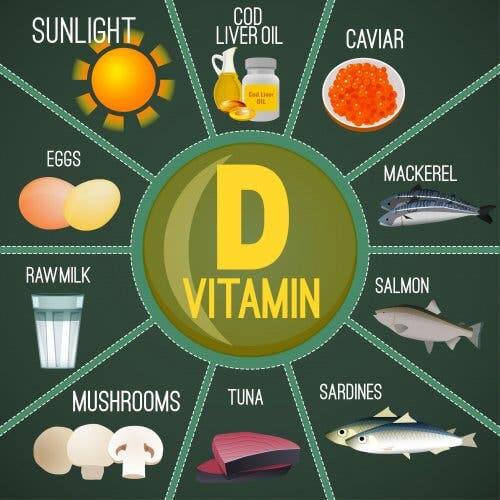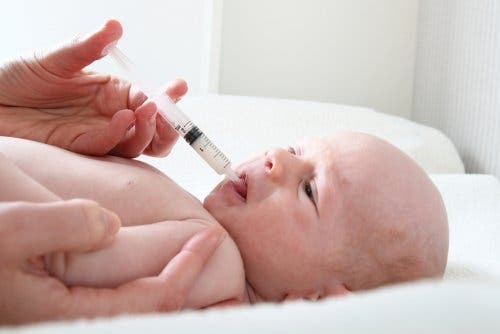Why Give Vitamin D to Children?


Written and verified by the biologist Olga Carbajo
Currently, there’s a lot of controversy when it comes to vitamin D supplements in infants under six months old. In breast milk, there’s lots of vitamin D and usually that’s sufficient. However, sometimes pediatricians say why you should give vitamin D to children from birth.
It’s true that our habits have changed, and our lifestyle is far from when we grew up. Now, the dangers of ultraviolet light cause children to go outside with more clothes than necessary, and covered in sunscreen. Now, the sun’s rays don’t penetrate their skin, and they don’t synthesize vitamin D as much.
What is vitamin D and what is it for?
Vitamins are compounds that our bodies need to grow and function normally. Vitamin D is present in all the cells in our bodies. It’s also responsible for the absorption of calcium, an essential element for bone growth.
In addition, you can get vitamin D from foods like egg yolk or liver. We can also get it from vitamin supplements, or through the skin after exposure to the sun. Our bodies synthesize vitamin D naturally. However, being in the sun for too long can cause skin cancer or premature skin aging.

For children, it’s a fundamental component, along with calcium, to grow up healthy and strong. It also helps prevents rickets. On the other hand, when we get old, it’s essential to avoid bone diseases like osteoporosis. It has several functions, but these are the most important:
- Helps the body absorb calcium, both in food and supplements.
- Muscles use it to move.
- Nerves use it to transmit messages to the brain and every part of the body.
- The immune system uses it to fight viruses and bacteria.
Symptoms and consequences of vitamin D deficiency
Vitamin D deficiency doesn’t cause obvious signs, but we can see some symptoms that make us think we might need a little extra. For example, you might notice tiredness, bone pain or muscle weakness. Also, this deficiency could be related to a poor diet. This could lead to injuries like fractures, rickets, or loss of bone mass.
Other factors related to deficiency are intestinal absorption problems, lack of exposure to sunlight or liver and kidney malfunctions, being unable to transform vitamin D from your diet into its active ingredient. In some cases, there seems to be a close relationship with conditions like diabetes, cancer or autoimmune diseases like sclerosis.
Give vitamin D to children to prevent disease
According to the World Health Organization (WHO), 42% of children in the world show signs of malnutrition and rickets. Although this isn’t a large problem in developed countries, it warns us that newborns have a very low amount of vitamin D.

Because of the important functions it performs and the lack of sunlight they get, the WHO recommends giving newborns extra vitamin D.
The recommended daily amount will depend on age, and your doctor will tell you the best dose and when to give vitamin D to children. However, don’t forget that too much vitamin D can also be harmful.
The Spanish Agency of Medicines and Health Products warns that severe cases of hypercalcemia in newborns is associated with giving babies too much cholecalciferol.
On its part, the American Academy of Pediatrics acknowledges that the recommended daily amount of vitamin D and the threshold for deficiency is still under debate. However, they recommend a daily dose of 400 IU (International Units) shortly after birth and throughout much of childhood.
“We need to do more research before we can make specific recommendations.”
– WHO –
Currently, there’s a lot of controversy when it comes to vitamin D supplements in infants under six months old. In breast milk, there’s lots of vitamin D and usually that’s sufficient. However, sometimes pediatricians say why you should give vitamin D to children from birth.
It’s true that our habits have changed, and our lifestyle is far from when we grew up. Now, the dangers of ultraviolet light cause children to go outside with more clothes than necessary, and covered in sunscreen. Now, the sun’s rays don’t penetrate their skin, and they don’t synthesize vitamin D as much.
What is vitamin D and what is it for?
Vitamins are compounds that our bodies need to grow and function normally. Vitamin D is present in all the cells in our bodies. It’s also responsible for the absorption of calcium, an essential element for bone growth.
In addition, you can get vitamin D from foods like egg yolk or liver. We can also get it from vitamin supplements, or through the skin after exposure to the sun. Our bodies synthesize vitamin D naturally. However, being in the sun for too long can cause skin cancer or premature skin aging.

For children, it’s a fundamental component, along with calcium, to grow up healthy and strong. It also helps prevents rickets. On the other hand, when we get old, it’s essential to avoid bone diseases like osteoporosis. It has several functions, but these are the most important:
- Helps the body absorb calcium, both in food and supplements.
- Muscles use it to move.
- Nerves use it to transmit messages to the brain and every part of the body.
- The immune system uses it to fight viruses and bacteria.
Symptoms and consequences of vitamin D deficiency
Vitamin D deficiency doesn’t cause obvious signs, but we can see some symptoms that make us think we might need a little extra. For example, you might notice tiredness, bone pain or muscle weakness. Also, this deficiency could be related to a poor diet. This could lead to injuries like fractures, rickets, or loss of bone mass.
Other factors related to deficiency are intestinal absorption problems, lack of exposure to sunlight or liver and kidney malfunctions, being unable to transform vitamin D from your diet into its active ingredient. In some cases, there seems to be a close relationship with conditions like diabetes, cancer or autoimmune diseases like sclerosis.
Give vitamin D to children to prevent disease
According to the World Health Organization (WHO), 42% of children in the world show signs of malnutrition and rickets. Although this isn’t a large problem in developed countries, it warns us that newborns have a very low amount of vitamin D.

Because of the important functions it performs and the lack of sunlight they get, the WHO recommends giving newborns extra vitamin D.
The recommended daily amount will depend on age, and your doctor will tell you the best dose and when to give vitamin D to children. However, don’t forget that too much vitamin D can also be harmful.
The Spanish Agency of Medicines and Health Products warns that severe cases of hypercalcemia in newborns is associated with giving babies too much cholecalciferol.
On its part, the American Academy of Pediatrics acknowledges that the recommended daily amount of vitamin D and the threshold for deficiency is still under debate. However, they recommend a daily dose of 400 IU (International Units) shortly after birth and throughout much of childhood.
“We need to do more research before we can make specific recommendations.”
– WHO –
All cited sources were thoroughly reviewed by our team to ensure their quality, reliability, currency, and validity. The bibliography of this article was considered reliable and of academic or scientific accuracy.
- AEMPS. (19 de marzo 2019).Vitamina D: casos graves de hipercalcemia por sobredosificación en adultos y pediátricas [MUH(FV), 2/2019]. Recuperado de: www.aemps.gov
- OMS. (última consulta julio 2019). Administración de suplementos de Vitamina D [artículo en web]. Recuperado de: www.who.int
- MEDLINE. (última consulta julio 2019). Deficiencia de Vitamina D. [artículo en web especializada]. Recuperado de: www.medlineplus.gov
This text is provided for informational purposes only and does not replace consultation with a professional. If in doubt, consult your specialist.








